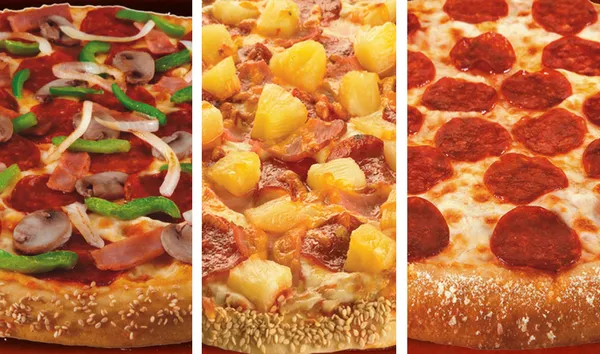Who Invented Pizza?

Pizza is among the most popular foods in the United States–with 15% of Americans claiming it as their favorite comfort food. But who invented pizza? The debate surrounding the history of the ooey-gooey dish is almost as extensive as the argument of whether or not pineapple belongs on a pie.
While pizza is beloved food here in America, many assume it's originally an Italian invention, though this may not be the case. Famous baker Raffaele Esposito, from Naples, Italy, often receives credit for the food's inception in the 1800s. What we see in pizzas today is the modernized version that Esposito cooked up. The classic bread, sauce, and toppings come to mind when envisioning your weekend take-out order.
The pies crafted by Esposito first came to America via Italian immigrants in the late 1800s. A gentleman named Gennaro Lombardi gained a name for himself when he opened the first official American pizzeria in Manhattan. Demand for the food exploded following WWII when swarms of soldiers previously stationed in Italy returned home. From there, pizza shops began opening across the United States.
But the history of pizza dates back thousands of years. This makes sense since, today, it's still a favorite. For thousands of years, other civilizations all around the world have loved pizza too. However, the big question remains–who invented pizza, and when?
Who Invented Pizza?
While modernized pizza made its way to America in the late 1800s, ancient civilizations have enjoyed various creations of the dish for thousands of years. The debate on who invented pizza first is tedious as the food has evolved throughout history.
5+ Civilizations We Know Loved Pizza
Historians have collected a list of ancient groups, civilizations, and countries with traces of pizza as a staple food long before reaching modern Italy. For these purposes, experts define pizza as flattened bread with toppings.
1) The Persians
Dating back to the 6th century BC, the Persian Empire consumed a variation of pizza. Under King Darius I and his vast army, the troops needed to find a way to feed large numbers of themselves to stay strong enough to ward off enemies. Using their metal battle shields, easily heated by flame, the men began to bake flatbread with a cheese topping. The result was a dish that much resembles what pizza looked like today.
2) The Greeks
The Persians had friendly ally states, including some regions in Greece, throughout and past wartime (and the Persians fought many). As friends, the Persians wanted to ensure their neighbors were fed well. Sharing their quick and simple recipe with the Greeks made sense. Their flatbreads with cheese and other toppings took little time to bake but were also filling. Many believe this is how ancient pizza began to spread worldwide.
Ancient Greeks, when home, had more time to experiment with the dish to make it more flavorful. This was when they introduced toppings like herbs, garlic, and onions.
3) The Romans
The ancient Romans also consumed a variety of pizzas–especially Jewish Romans who ate kosher cookies during Passover. The use of Italian paschal bread, which many now call Easter Bread. While the list of toppings, if any, is unknown, the bread is undoubtedly similar to the base of pizzas we see today.
However, at its peak, the Roman Empire sprawled through most of modern-day Europe and some areas in the Middle East and Africa. Throughout the Empire's lifetime, it's thought that populations on the Balearic Islands, the Balkans, the Levant, Catalonia, and Valencia all crafted some form of pizza.
4) Ancient Mediterraneans
Ancient Mediterraneans also ate a version of "pizza." They consumed a large amount of focaccia, leavened flat-baked bread. Today, many refer to it as "pizza bianca" or "white pizza." The dish was both savory and sweet and was topped with rosemary, basil, sage, and salt.
5) Other Notable Mentions
Since flatbread with toppings is considered the base recipe for pizza, it's important to note that countless other regions of the world consumed very similar foods. These populations include the Chinese bing, which consists of a flat or circular bread base. Indians famously ate paratha, a fatty bread mixed with spiced potatoes, a vibrant mix of veggies, meat, and more. They often added curries and fried eggs into servings of the dish.
Additionally, populations dating back to ancient South/Central Asia, those of Finnish background, Germany, and France all ate versions of flatbread with filling or toppings for many hundreds of years.
Hungry Howie's History
The history of Hungry Howie's starts in 1973, with one location in Michigan. By 1982 the restaurant gained enough popularity to begin franchising, and by 1990, 160 sites were in business. Today, more than 550 Hungry Howies locations reside within 22 states, making it a nationwide success.
Place Your Order Today
At Hungry Howie's, we're known for making a mean pizza. As the inventors of the original Flavored Crust, you can add an extra boost to your taste experience. With other offerings, including Howie Bread, Howie Wings, Baked Subs, fresh salads, soft drinks, and dessert, we have you covered when grabbing a full meal.
Order for take-out or delivery today.
